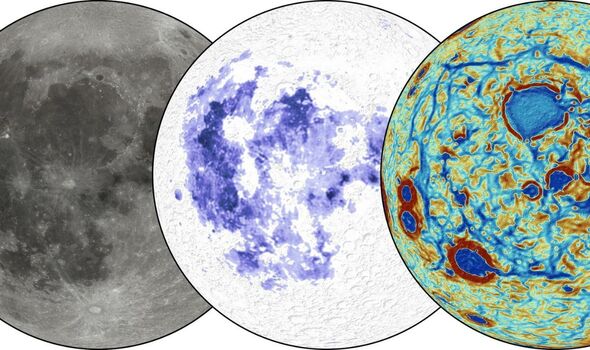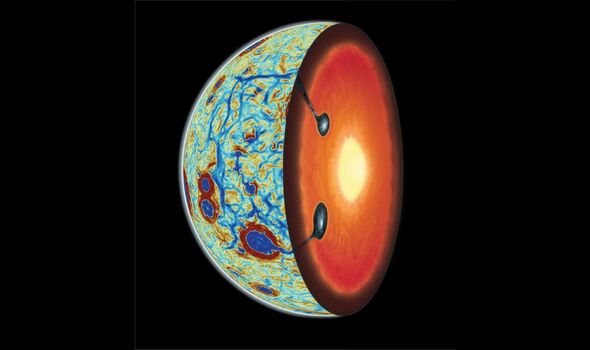
Oceans of magma sank and rose to the moon’s surface over billions of years to form its current shape (Image: SWNS)
The moon turned itself inside out to to form the cratered surface we see today, according to scientsts.
Researchers combined computer simulations and data to show how oceans of magma sank and rose to the moon’s surface again over billions of years to form its current shape.
Astronomers say these magma oceans fluctuated over thousands of years due to gravitational instability.
The American research team say their findings could offer important insights into the evolution of our moon – and even potentially for planets such as the Earth and Mars.
Around 4.5 billion years ago, a small planet smashed into our own young planet, flinging molten rock into space.

As the molten rock gradually cooled and solidified, it formed the moon’s mantle. (Image: SWNS)
Over the proceeding millennia, the resulting debris slowly combined, cooled and solidified – forming our moon.
However, the details of how this process occurred have thus far remained heavily debated by astronomers.
Most of our knowledge on the origins of the moon comes from analyses of rock samples collected by Apollo astronauts over 50 years ago, combined with theoretical models.
Samples of basaltic lava rocks showed surprisingly high concentrations of titanium, whilst later satellite observations found that these titanium-rich volcanic rocks are primarily located on the moon’s nearside.
But how and why they got there has remained a mystery, until now.
As the moon formed fast and hot, it was likely covered by a global magma ocean.
As the molten rock gradually cooled and solidified, it formed the moon’s mantle and the bright crust we see when we look up at a full moon at night.
But deeper below the surface, the young moon was wildly out of equilibrium.
Models suggest that the last dregs of the magma ocean crystallised into dense minerals including ilmenite, a mineral containing titanium and iron.
Weigang Liang, who led the research as part of his doctoral work at the University of Arizona’s Lunar and Planetary Laboratory (LPL), explained: “Because these heavy minerals are denser than the mantle underneath, it creates a gravitational instability, and you would expect this layer to sink deeper into the moon’s interior.”
In the millennia that followed that dense material sank into the interior, mixed with the mantle, then melted and returned to the surface as the titanium-rich lava flows that we see on the surface today.
“Our moon literally turned itself inside out,” co-author Dr Jeff Andrews-Hanna, an associate professor at LPL, said.
“But there has been little physical evidence to shed light on the exact sequence of events during this critical phase of lunar history, and there is a lot of disagreement in the details of what went down – literally.”
On the many possibilities, such as whether this material gradually sank or did so all at once after the moon fully solidified, Dr Adrien Broquet, of the German Aerospace Center in Berlin, said: “Without evidence, you can pick your favourite model.

‘The moon is fundamentally lopsided in every respect.’ (Image: SWNS)
“Each model holds profound implications for the geologic evolution of our moon.”
In a previous study from Peking University in Beijing, models predicted that the dense layer of titanium-rich material beneath the crust first migrated to the near side of the moon, possibly triggered by a giant impact on the far side, and then sank into the interior in a network of sheetlike slabs, cascading into the lunar interior almost like waterfalls.
But, when that material sank, it left behind a small remnant in a geometric pattern of intersecting linear bodies of dense titanium-rich material beneath the crust.
“When we saw those model predictions, it was like a lightbulb went on,” Dr Andrews-Hanna said, “because we see the exact same pattern when we look at subtle variations in the moon’s gravity field, revealing a network of dense material lurking below the crust.”
In the new study, the researchers compared simulations of a sinking ilmenite-rich layer to a set of linear gravity anomalies detected by NASA’s GRAIL mission, whose two spacecraft orbited the moon between 2011 and 2012, measuring tiny variations in its gravitational pull.
These linear anomalies surround a vast dark region of the lunar near side covered by volcanic flows known as ‘mare’ – the Latin word for ‘sea’.
The team found the gravity signatures measured by the GRAIL mission are consistent with ilmenite layer simulations, and that the gravity field can be used to map out the distribution of the ilmenite remnants left after the sinking of the majority of the dense layer.
“Our analyses show that the models and data are telling one remarkably consistent story,” Liang explained.
“Ilmenite materials migrated to the near side and sunk into the interior in sheetlike cascades, leaving behind a vestige that causes anomalies in the moon’s gravity field, as seen by GRAIL.”
The researchers’ observations also constrain the timing of this event: the linear gravity anomalies are interrupted by the largest and oldest impact basins on the near side and therefore must have formed earlier.
Based on these cross-cutting relationships, the authors suggest the ilmenite-rich layer sank prior to 4.22 billion years ago – making it consistent with contributing to later volcanism seen on the lunar surface.
“Analysing these variations in the moon’s gravity field allowed us to peek under the moon’s surface and see what lies beneath,” Dr Broquet said.
Whilst the detection of lunar gravity anomalies provides evidence for the sinking of a dense layer in the moon’s interior and a more precise estimate of how and when this occurred, the researchers say that what we see on the surface of the moon adds even more intrigue to the story.
“The moon is fundamentally lopsided in every respect,” Dr Andrews-Hanna said.
The researchers explained the near side facing the Earth – particularly the dark Oceanus Procellarum region – is lower in elevation, has a thinner crust, is largely covered in lava flows and has high concentrations of typically rare elements like titanium and thorium, whereas the far side differs in each of these respects.
Somehow, the overturn of the lunar mantle is thought to be related to the unique structure and history of the near-side Procellarum region, though the details of that overturn have been a matter of considerable debate among scientists.
“For the first time, we have physical evidence showing us what was happening in the moon’s interior during this critical stage in its evolution – and that’s really exciting,” Dr Andrews-Hanna said.
“It turns out that the moon’s earliest history is written below the surface, and it just took the right combination of models and data to unveil that story.”
“The vestiges of early lunar evolution are present below the crust today, which is mesmerising,” Dr Broquet added.
“Future missions, such as with a seismic network, would allow a better investigation of the geometry of these structures.”
Mr Liang added that research such as this could assist astronauts on upcoming manned missions to the moon, saying: “When the Artemis astronauts eventually land on the moon to begin a new era of human exploration, we will have a very different understanding of our neighbour than we did when the Apollo astronauts first set foot on it.”











